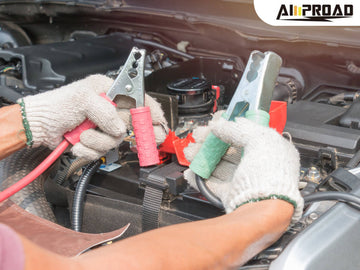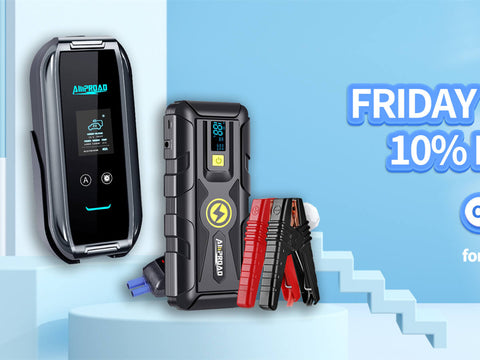
Garage storage for your jump starter: convenient or risky? Explore temperature dangers & safety tips. Find alternative storage solutions to keep your car's backup juice box safe.
A dead car battery can put a damper on your day, but a portable jump starter can be a lifesaver. These compact devices deliver a quick jolt to get your car back up and running. But where should you keep your jump starter? The garage might seem like a convenient option, but it could also pose some hidden dangers. Extreme temperatures, lurking dust, and even the summer sun can wreak havoc on your jump starter's delicate insides. So, is your garage really the best place to store this trusty roadside companion? We'll explore the potential risks and how to keep your jump starter safe, ensuring it's always ready to answer the call when your battery fails.
What Are the Safety Concerns in the Garage?
When it comes to storing a jump starter in your garage, it's essential to consider potential safety concerns that may arise from the environment. Here are some key factors to weigh when assessing the safety of storing your jump starter in the garage:
Temperature Extremes
Garages can be subject to temperature extremes, especially during the summer and winter months. Excessive heat during the summer can have detrimental effects on the jump starter's battery, leading to degradation in performance and an increased risk of explosion. On the other hand, extreme cold in the winter can hinder the battery's ability to hold a charge and reduce its cranking power when needed. It's crucial to store your jump starter in a location within the garage that is shielded from direct sunlight and insulated from extreme temperature fluctuations to maintain its performance and safety.
Direct Sunlight
Direct sunlight exposure can also pose a risk to the integrity of the jump starter. Prolonged exposure to UV rays can cause damage to the jump starter's casing and internal components over time, potentially compromising its functionality and safety. To mitigate this risk, consider storing the jump starter in a shaded area of the garage or using a protective cover to shield it from direct sunlight when not in use.
Exposure to Dust, Moisture, and Spills
Garages can be prone to dust accumulation, moisture ingress, and accidental spills, all of which can pose risks to the jump starter's operation. Dust and debris can accumulate on the jump starter's exterior and vents, obstructing airflow and causing overheating. Moisture ingress can lead to corrosion of internal components, affecting the jump starter's performance and reliability. Additionally, accidental spills of liquids such as water, oil, or chemicals can cause short circuits or other electrical malfunctions. To minimize these risks, store the battery booster in a clean, dry area of the garage, away from potential sources of moisture and spills.
By considering these safety concerns and taking appropriate precautions, you can ensure that storing your jump starter in the garage is done safely and responsibly, maintaining its performance and reliability for when you need it most.
Storage Strategies for Your Garage

When it comes to safely storing your jump starter in the garage, there are a few key strategies to keep in mind. Here are some tips to help you store your jump starter securely and maintain its performance:
Choose the Right Location
Opt for a cool, dry spot in your garage to store your jump starter. Avoid areas that are exposed to direct sunlight or heat sources, as prolonged exposure to high temperatures can degrade the battery and other components over time. By selecting a cool and dry location, you can help preserve the integrity of your jump starter and extend its lifespan.
Invest in a Sturdy Carrying Case
Consider investing in a sturdy carrying case or protective cover for your jump starter, such as the AMPROAD jump starter, which is offered with a sturdy carrying case. A quality carrying case provides an extra layer of protection against dust, moisture, and impacts, helping to safeguard your jump starter from damage during storage and transportation. Look for a case with durable materials and ample padding to shield your jump starter from potential hazards in the garage environment. With a reliable carrying case, you can store your jump starter confidently, knowing that it is well-protected and ready for use whenever needed.
Regularly Inspect for Damage
Make it a habit to regularly inspect your jump starter for any signs of damage, overheating, or leaks. Check for cracks or dents in the casing, loose or frayed wires, and any unusual odors or sounds coming from the unit. Additionally, monitor the battery status indicator lights to ensure they are functioning correctly. If you notice any signs of damage or malfunction, discontinue use of the jump starter and address the issue promptly to prevent further damage or safety hazards.
By following these storage strategies, you can ensure that your jump starter is safely stored in your garage and ready for use whenever you need it. Choosing the right location, investing in a sturdy carrying case, and regularly inspecting for damage are essential steps to maintaining the performance and reliability of your jump starter for years to come.
Are There Any other Storage Options?
For those who prefer to explore alternative storage solutions for their car booster pack, there are several options to consider outside of garage storage. Here are a couple of alternative storage solutions:
Indoor Storage at Room Temperature
Storing your jump starter indoors at room temperature can provide a controlled environment that helps maintain its performance and longevity. Consider keeping it in a closet or utility room where it's easily accessible yet protected from temperature extremes, direct sunlight, and moisture. Indoor storage can also help prevent dust accumulation and potential damage from garage-related hazards.
Keep it in the Trunk of Your Car
Another convenient storage option is to keep your jump starter readily accessible in the trunk of your car. Many modern vehicles come equipped with dedicated storage compartments or compartments specifically designed to hold emergency roadside assistance equipment, including jump starters. By storing your jump starter in the trunk, you ensure that it's always on hand in case of emergencies while minimizing clutter inside your home or garage.
When considering alternative storage options for your jump starter, prioritize accessibility, protection from environmental hazards, and ease of use. Whether you opt for indoor storage at room temperature or keeping it in the trunk of your car, the goal is to ensure that your jump starter remains in optimal condition and ready for use whenever you need it.
By carefully weighing the pros and cons of each storage solution and choosing the one that best fits your needs and preferences, you can ensure that your jump starter is safely stored and readily available for emergency situations like how to boost a car.
FAQs / People Also Ask
1. Can I store my jump starter in the garage during extreme temperatures?
Storing your jump starter in the garage during extreme temperatures can pose risks to its performance and longevity. Excessive heat during the summer can degrade the battery and other components, while extreme cold in the winter can reduce its cranking power. It's best to choose a cool, dry location away from direct sunlight and heat sources for optimal storage conditions.
2. Is it safe to store my jump starter in the trunk of my car?
Storing your jump starter in the trunk of your car can be a convenient option, especially for emergency roadside assistance. However, it's essential to ensure that the trunk environment is not subject to extreme temperatures or moisture, as these conditions can impact the jump starter's performance. Additionally, securely fasten the jump starter to prevent movement during vehicle operation.
3. How often should I inspect my jump starter for damage?
Regular inspections of your jump starter are crucial to identify any signs of damage or wear early on. It's recommended to inspect your jump starter before each use and periodically throughout its storage period. Look for visible cracks, dents, or fraying in the casing, loose wires, or any unusual odors or sounds coming from the unit. Addressing any issues promptly can help prevent further damage and ensure the safety and effectiveness of your jump starter.
4. Can I store my jump starter in a carrying case?
Storing your jump starter in a sturdy carrying case can provide an extra layer of protection against dust, moisture, and impacts. Look for a case with durable materials and ample padding to shield your jump starter from potential hazards during storage and transportation. Be sure to properly secure the jump starter in the carrying case and store it in a cool, dry location for optimal protection.
5. How do I maintain the battery life of my jump starter during storage?
To maintain the battery life of your jump starter during storage, it's essential to follow proper storage practices. Store the jump starter in a cool, dry location away from direct sunlight and heat sources. Avoid storing it in extreme temperatures or exposing it to moisture, as these conditions can degrade the battery over time. Additionally, periodically charge the jump starter according to the manufacturer's recommendations to keep the battery topped up and ready for use when needed.



